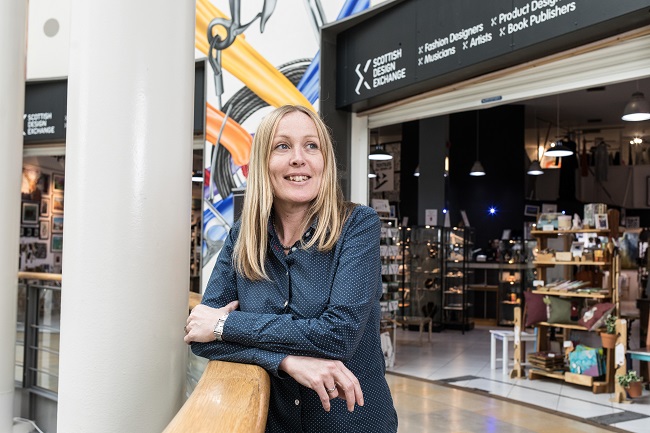And finally… most Scottish artists earn less than £8k a year
Most self-employed artists in Scotland earn less than £8000 a year from their work, according to a study, prompting calls for art schools and colleges to offer business advice and training to undergraduate students.

Lynzi Leroy, founder of the Scottish Design Exchange
A survey of more than 100 artists and craftspeople by the Scottish Design Exchange (SDX) revealed that 58 per cent struggled to make ends meet, earning just £5000-£8000. Only 8 per cent earned more than £20,000 with 5 per cent earning more than £30,000.
Only 17 per cent said they had ever received funding or financial support. Fewer than half, 46 per cent said they had received support from organisations such as Business Gateway or Creative Scotland.
Of those, 31 per cent said they’d received business advice, 28 per cent had attended workshops and 12 per cent had attended networking events.
Lynzi Leroy, the entrepreneur behind the SDX which provides a high street presence to artists and craftspeople, said many graduates from art schools and colleges are failing to capitalise on their skills and talents because they don’t know how to market themselves.
The social enterprise, which has helped more than 300 artists to sell their products since its launch in 2015, recently introduced business-focused workshops for its clients to plug the gap but Leroy insists more must be done.
Lynzi Leroy, its chief executive, said: “We hear the same thing from a lot of young artists. Even those who do have some business acumen find that the cost of marketing and retail space is prohibitively expensive.
“Scotland has a wealth of emerging creative talent and we should be giving these young artists and designers all the help we can. Instead, it seems, we’re placing obstacles in their way and so it’s no surprise that many of them become disillusioned or find that they simply can’t afford to become fully professional.”
SDX surveyed 130 artists, fashion, textile and jewellery designers, publishers, photographers and other craft producers whose products are sold at its twin outlets at Ocean Terminal, in Leith and Buchanan Galleries, in Glasgow.
The greatest number, 38 per cent considered themselves to be an artist first and foremost, while 22 per cent regarded themselves as makers. Only 15 per cent perceived that they were business people and many regarded social isolation as a problem for them.
Of those who work at home, one in four (23 per cent) said they had no contact with other artists or groups during working hours. Of those who did 34 per cent said contact with others was limited to once or twice a month and 14 per cent said their only contact with peers was through SDX. Of the rest, 10 per cent said they had regular contact with other artists while 17 per cent said they met up with others once or twice a week.
Three quarters of artists said they regarded what they did as a lonely profession. Almost a third (30 per cent) said they often experienced social isolation while 35 per cent said they suffered occasional social isolation.
Leroy said: “Not many artists are business-minded and it can be a real drawback. One of the things you don’t get at art school is much in the way of business advice. It’s an area that is conspicuously missing from the curriculum.
“Students are so focused on their discipline and getting their qualification, they don’t give much thought to the fact that, when they graduate, they will, in all likelihood, be self-employed and will have to think about things like marketing and the cost of setting up in business.
She added: “It’s an area in which I feel students could do with getting more help in lots of disciplines. After you graduate you feel you’re always trying to bridge a gap between designing and making your products and selling them.”
More than four in five respondents said they obtained goods and services necessary to run their business in the UK, and 72 per cent from Scotland. Only 24 per cent obtained materials and services from other EU countries and 20 per cent from the rest of the world.
Some 81 per cent said they sold their products in Scotland with only 9 per cent selling in the rest of the UK, 8 per cent selling to the rest of the world and just 1 per cent selling within the EU.
Other than the Scottish Design Exchange (SDX) 28 per cent said they sold their products through Etsy, 27 per cent through other local retailers, 24 per centthrough their own online store and 17 per cent at markets. Only 2 per cent sold through national retailers.
Some 42 per cent or artists said they were targeting growth of 25 per cent in the coming year with 28 per cent aiming for 50 per cent growth, 17 per cent eyeing 100 per cent growth and 17 per cent seeking to achieve growth of 150 per cent or more.
Artists had higher medium-term ambitions with almost a third (29 per cent) hoping to achieve growth of 150 per cent in the next five years, more than a quarter (27 per cent) seeking 100 per cent growth and almost the same number (23 per cent) targeting 50 per cent growth.
By far the greatest number (48 per cent) saw Scotland as their principal market in the future with 26 per cent aiming to sell mostly in the rest of the UK and 20 per cent eyeing the rest of the world as their primary focus for sales. Only 4 per cent saw the rest of the EU as their primary market.



